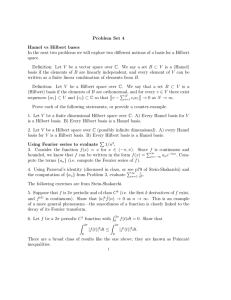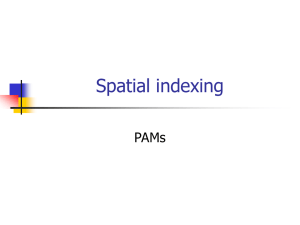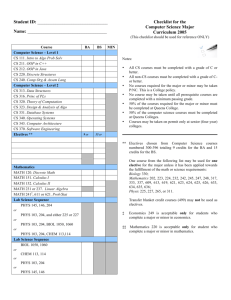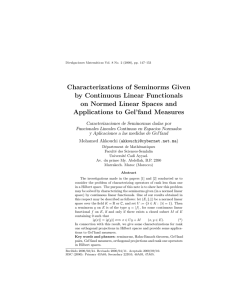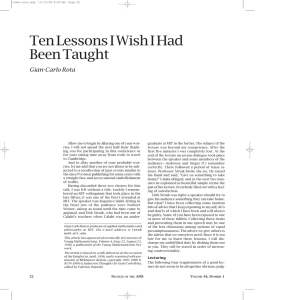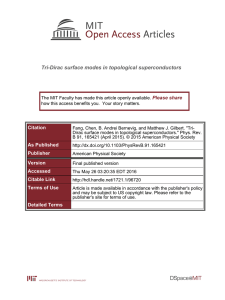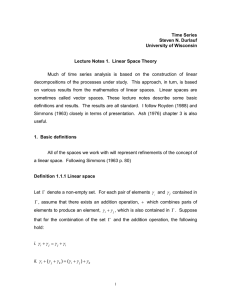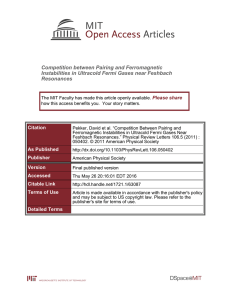Weinberg's Laws of Progress in Theoretical Physics First Law: “The
advertisement
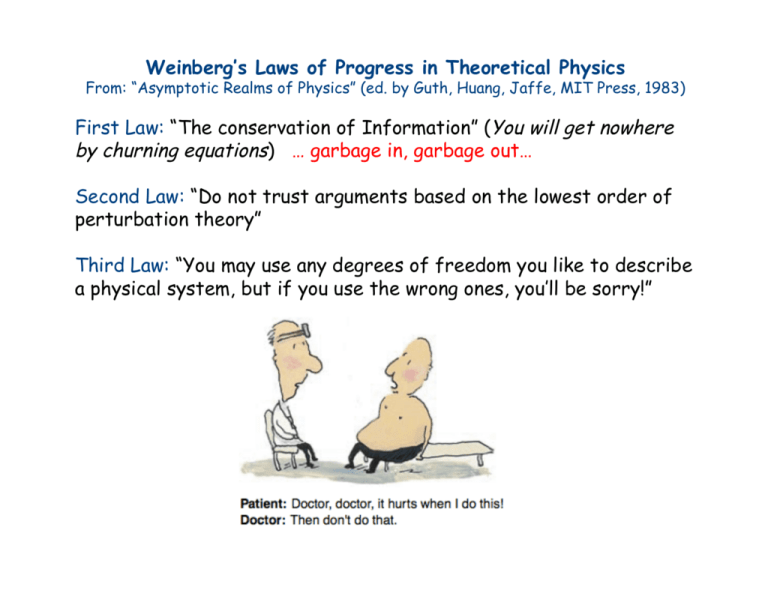
Weinberg’s Laws of Progress in Theoretical Physics From: “Asymptotic Realms of Physics” (ed. by Guth, Huang, Jaffe, MIT Press, 1983) First Law: “The conservation of Information” (You will get nowhere by churning equations) … garbage in, garbage out… Second Law: “Do not trust arguments based on the lowest order of perturbation theory” Third Law: “You may use any degrees of freedom you like to describe a physical system, but if you use the wrong ones, you’ll be sorry!” A remark: physics of open nuclei is demanding ! Interactions Interactions Many-body Correlations Configuration interaction • Mean-field concept often questionable • Asymmetry of proton and neutron Fermi surfaces gives rise to new couplings • New collective modes; polarization effects • Poorly-known spin-isospin components come into play • Long isotopic chains crucial Open Channels Open channels • Nuclei are open quantum systems • Exotic nuclei have low-energy decay thresholds • Coupling to the continuum important • Virtual scattering • Unbound states • Impact on in-medium Interactions In mathematics, a rigged Hilbert space (Gel’fand triple, nested Hilbert space, equipped Hilbert space) is a construction designed to link the distribution and square-integrable aspects of functional analysis. Such spaces were introduced to study spectral theory in the broad sense. They can bring together the 'bound state' (eigenvector) and 'continuous spectrum', in one place. Mathematical foundations in the 1960s by Gel’fand et al. who combined Hilbert space with the theory of distributions. Hence, the RHS, rather than the Hilbert space alone, is the natural mathematical setting of Quantum Mechanics I. M. Gel’fand and N. J. Vilenkin. Generalized Functions, vol. 4: Some Applications of Harmonic Analysis. Rigged Hilbert Spaces. Academic Press, New York, 1964. J.J. Thompson, 1884 G. Gamow, 1928 relation between decay width and decay probability A comment on the time scale… ∂ψ ˆ i = Hψ ∂t T1/ 2 = ln2 , Γ Ts. p.€ ≈ 3⋅10 −22 € = 6.58 ⋅10−22 MeV ⋅ sec sec = 3babysec. 238U: T1/2=1016 years 256Fm: T =3 hours 1/2 The usual starting point: one body Schrödinger equation: U(r) at large distances… R asymptotically… r We are interested in the expectation value: inner contribution (r<R) outer contribution (r>R) The inner integral is always finite. The outer integral can be written as: In the limit of a very weak binding, one can use the asymptotic expressions for the Hankel functions. This yields: If pairing is present, this picture changes: K. Bennaceur et al., Phys. Lett. B496, 154 (2000) B(N + 1,Z) + B(N −1,Z) 2 B(N,Z + 1) + B(N,Z −1) Δ p = B(N,Z ) − 2 Δ n = B(N,Z ) − for odd-N for even-N The single-particle field characterized by λ, determined by the p-h component of the effective interaction, and the pairing field Δ determined by the pairing part of the effective interaction are equally important when S1n is small. If pairing is present, the picture of halo changes: K. Bennaceur et al., Phys. Lett. B496, 154 (2000) Pairing Antihalo Effect • square-well potential • spherical symmetry • l=0 (s-wave) Radial Schrödinger equation 2M χ ''+ 2 (E − V ) χ = 0 ( χ = ϕr) Region I: χ I = Asin pr, Region II: χ II = c +e € Region III: q(r−a ) 2ME p = 2 2 + c−e −q(r−a ) 2M(Vb − E) , q = 2 χ III = c1e ip(r−b ) + c 2e−ip(r−b ) 2 In almost all cases |χIII| is much larger than |χI|. We are now interested in those situations where |χIII| is as small as possible.! The condition p c + = 0 ⇒ tan( pa) = − q defines “virtual” levels in region I: particle is well localized; very small penetrability through the barrier open closed H(t) = H 0 + V (t) (V << H 0 ) time-dependent Hamiltonian ∂ψ ˆ = Hψ …expansion of ψ in the basis of Ho ∂t Hˆ 0φ n = E n φ n ⇒ ψ = ∑ c n (t)φ n e−iE n t / i € n i dc k = ∑ c n (t) φ k V φ n e iω kn t , ω kn = ( E k − E n ) / dt n € As initial conditions, let us assume that at t=0 the system is in the state φ0. That is, € 1 for n = 0 c n (0) = 0 for n ≠ 0 If the perturbation is weak, in the first order, we obtain: € i dc k = φ k V φ 0 e iω t k0 dt Furthermore, if the time variation of V is slow compared with exp(iωkot), we may treat the matrix element of V as a constant. In this approximation: c k (t) = φk V φ0 1− e iω k 0 t ) ( Ek − E0 The probability for finding the system in state k at time t if it started from state 0 € t=0 is: at time 2 2 c k (t) = 2 φk V φ0 (Ek − E0) 2 (1− cosω k 0 t ) € total probability to decay to a group of states within some interval labeled The by f equals: 2 ∑ c k (t) = k∈ f € 2 2 ∫ φk V φ0 ω 2 k0 2 (1− cosω k 0 t )ρ( E k ) dE k The transition probability per unit time is W = € d 2 2 c (t) = ∑ k dt k ∈ f 2 2 sin ω k 0 t ρ( E k ) dE k ωk0 Since the function sin(x)/x oscillates very quickly except for x~0, only small region around E0 can contribute to this integral. In this small energy region we may regard the matrix element and the state density to be constant. This finally gives: W0 → f 2 2π = φ f V φ 0 ρ( E f ) € ∞ sin x ∫ x dx = π −∞ € ∫ φk V φ0 Fermi’s golden rule T1/ 2 = ln2 , Γ −22 Ts. p. ≈ 3⋅10 = 6.58 ⋅10 −22 sec = 3babysec. T1/ 2 >> Ts.p. € € Γ << 1MeV € € MeV ⋅ sec A typical time associated with the s.p. motion Baumann et al., ENAM’08 Extrapolates very well! the difference of mass excess of projectile and target ? € V ( r) = U ( r ) + W ( r) W˜ = W + V0 eigenstate of T+U with E=E0 eigenstate ~ of T+W with E=E0 Isolated Breit-Wigner resonance; Fermi’s golden rule Two-body case, 1-neutron halo Bertulani and Baur, Nucl. Phys. A480, 615 (1988) Nagarajan, Lenzi, ViCuri, Eur. Phys. J. A24, 63 (2005) 19C Ec Eb=-Sn For transiJon: It has maximum at Three-body case, 2-neutron halo Pushkin, Jonson, and Zhukov, J. Phys. G 22, L95 (1996) 11Li

